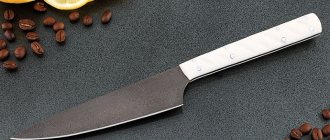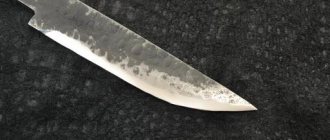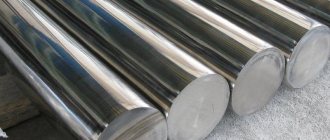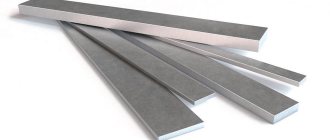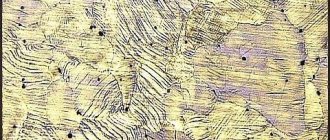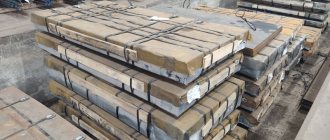Damask steel knives have long been overgrown with myths and legends. Some believe that this is a unique steel, capable of cutting any material, serving for decades, and the blade of the blade practically does not need sharpening. Others point out that, compared to current alloys, damask steel is losing ground significantly and is only suitable as a decorative adornment.
Let's try to give an objective assessment of damask steel and consider how and where it originated, what characteristics it has, how demanding it is to maintain, and whether it is in demand today.
The history of damask steel
Damask knives, like other weapons made from this material, have been known since ancient times. There is a common misconception that the first mention of damask steel was noted in Ancient India.
There, local blacksmiths learned to forge “wootz” - an unusually strong, but at the same time flexible material. There are several legends associated with this material that bear little resemblance to the truth:
- Indian craftsmen added various materials to hot steel to give it the required shade, for example, copper sulfate powder;
- There were sabers made of damask steel that could be worn as a belt. Although, of course, it is unlikely that steel could be so flexible;
- arms sellers cut damask ingots in half to demonstrate to people the quality of the craftsman's work.
However, for the first time in history, this material was mentioned in Ancient Greece. Bulat in general, by the way, is often confused with Damascus steel.
There is a common misconception that the blade can have the same patterns as on weapons made of Damascus; the production technology itself excludes this possibility.
Other unscrupulous sellers take advantage of buyers’ ignorance and, under the guise of damask steel, sell ordinary steel, on which a similar design is applied.
In the “Tale of Igor’s Campaign” (XII century) it is said that the army of Vsevolod, Prince of Trubchevsky and Kursk, fought with the Polovtsians with damask swords. Damask steel was also mentioned in Russian documents from the 16th-17th centuries.
Metallurgist Pavel Anosov is considered to be the first to recreate the technology of damask steel production in our country after a long time. He spent many years, but in 1837 he was able to reproduce the technology for the production of damask steel, which had the properties described in early historical evidence.
However, P. Anosov did not leave information about how he received the “Russian damask steel”. Along with his death, forging technology was lost again, but only for a while.
Historical reference
In fairy tales and myths, heroes often wield superweapons. And these are swords made of damask steel - incredibly durable, never losing their sharpness, rare and valuable. The secret of the material lies in its chemical composition. Having discovered an alloy of iron and carbon, ancient gunsmiths learned that a higher content of the second component increases strength.
But at the same time the steel becomes brittle. Conversely, low-carbon alloys are soft and easy to process. In damask steel, high hardness is combined with strength and resistance to dynamic loads. And all thanks to the special structure of the alloy. Even on damask steel, a specific pattern always appears. From it, craftsmen could find out where the blade was forged.
It was believed that the damask sword had unique properties:
- Reached razor sharpness.
- Don't be stupid.
- Easily cut both silk and steel.
The secrets of patterned steel production were passed down exclusively within the blacksmith family. Initially, damask blades were produced in India. But after a series of wars of conquest, the masters ended up in Samarkand. And then traces of the mysterious material were lost for a long time.
Attempts to unravel the mystery of damask steel have been made repeatedly. For example, in the 19th century, the Russian metallurgist and scientist Pavel Anosov managed to reproduce the result. Through trial and error, he managed to achieve the famous quality of damask steel. Anosov not only recreated the method, but also classified the types of blades. He found that strength characteristics depend on the nature of the pattern. It is believed that a breakthrough in steel metallurgy, processing, and alloying was achieved thanks to the work of the scientist.
Many years later, in our time, entrepreneur Sergei Baranov mastered the forging of damask blades. The quality of the resulting steel was confirmed by experts.
How damask steel spread throughout the world
Damask steel gradually moved from the East to the West. There it was valued among local warriors and nobility for its characteristics, unique at that time, and its elegant appearance.
This material was used to create both weapons and armor in the past.
There are references to damask blades used during the war, as well as knives designed for hunting and cutting game.
It is believed that damask steel was developed as a substitute for Damascus steel. It was cheaper and less labor-intensive to produce - two layers of steel and proper heat treatment were enough to produce it.
At the same time, both Damascus and damask steel blades had approximately the same sharpness, but damask steel was still stronger.
Selection criteria, what you need to know when purchasing.
Folding pampukha knives
When choosing damask steel, it is important to pay attention to its characteristics, cost, and type. A quality instrument can be identified by the following criteria:
- The blade has a contrasting, clear pattern across its entire surface. This pattern indicates the correct hardening of the material, as well as the approximate composition of the steel. A pattern with a high degree of contrast can only be obtained when the carbon content in different types of steel differs by more than 0.4%.
- Absence and presence of lack of penetration. This is the name given to the areas between the layers where no welding has occurred. Lack of penetration significantly spoils the appearance of damask steel, and sometimes affects its operation.
- Sharpening quality. The cutting edge must be sharpened at a certain angle, evenly throughout its entire length.
The cutting edge must be sharpened at a certain angle, evenly throughout its entire length.
Production methods and materials
The secret of damask steel production has been revealed. It turned out that it was simple cast steel, obtained by alloying two types of iron. The secret thanks to which the blade received its characteristics was proper heat treatment:
- The metal was heated to a certain temperature;
- It was then slowly cooled.
- A crystallization effect occurred: cementite formed throughout the depth of the blade, as a result of which the steel became strong.
- They forged it with a lightweight hammer so as not to damage the cementite crystals that appeared.
It turns out that the difficulty lies not in the selection of source materials, but in the reproduction of the required temperature and the careful work of the blacksmith with steel.
Chemical composition and properties of damask steel
Bulat steel remains an alloy of iron and carbon. The latter is up to 2%. Strength characteristics are achieved not by alloying additives, but by special manufacturing technology. Every detail matters. Especially the temperature. Therefore, for the production of damask steel, instead of high-performance metallurgical furnaces heated by gas or electricity, wood-burning furnaces are used.
Nothing will come of an overheated alloy. Using another technology, steel layers were welded together. Not by electric arc or gas welding, but in the process of repeated reforging. This is how blades were made in Damascus, Japan. Traces of layers give a unique pattern on the blade.
Damask steel amazingly combines strength and elasticity. Knives made from it bend, but do not break. The blade can be brought to a razor sharpness. Holds an edge perfectly. Hardness on the Rockwell scale reaches 64 units.
Structure of damask steel knives
Knife blanks are made from pure materials that do not contain any impurities. For this, two types of steel are used:
- high-carbon, with a melting temperature of about 1500 C;
- low-carbon, which melts at T from 1150 to 1250 C depending on the carbon content.
When cooled, the blade becomes coated with a layer of carbon, making the weapon stronger. As a result, we can highlight the following pros and cons of damask weapons.
Among the advantages are:
- combination of hardness and elasticity of the blade;
- high wear resistance (with proper care the knife will last for more than one year);
- blade sharpness, not much inferior to current alloys.
Eight types of welded damask steel (damascus)
With Damascus, everything is much more interesting: there are at least eight varieties of welded damask steel, also known as Damascus. Before we get to them, it's worth making a quick note.
In principle, it is possible to create stainless Damascus. To do this, you need to assemble a package of steel alloyed with the necessary additives and start welding it in a vacuum, laying it in layers and unforging it, and then repeating this cycle again. Technically, this is quite difficult, but modern technologies successfully cope with the task, as exemplified by chef’s knives with patterned stainless steel linings.
Kanetsugu kitchen knife from the Tojiro range with patterned steel handles
"Wild" Damascus
This is the same damask that is obtained if the master does not use special tools and technologies, that is, if the process occurs naturally. Sheets of steel with different chemical compositions are folded together, welded and unforged; then they are cut in half, folded again, and all actions are repeated. The result is layered steel. If its forging does not have a clear plan, then the pattern turns out disordered, or “wild”.
“Wild” and simple damask are two subtypes of the technique, which has no characteristic features, but is the usual overlay of layers on top of each other, followed by free-style forging
Stamp Damascus
When making this type of patterned steel, the blacksmith uses a tool called a stamp: thanks to it, a beautiful pattern appears on the surface of the layered Damascus plate, not very reminiscent of the pattern on plain Damascus. Depending on the stamp's pattern, it may resemble a ladder, the growth layers of a tree cut, the surface of water in the rain, or a combination of these patterns.
Stamp Damascus is produced using a special tool - a stamp.
Mosaic Damascus
Mosaic damasks are often distinguished not only by the technology of forging, but also by the composition itself - the package is assembled in the manner of a mosaic from steel blanks of different shapes and compositions so that as a result of overlaying and forging, such a characteristic pattern is obtained.
The mosaic on the surface of this type of Damascus is the “merit” not of technology, but of the correct selection of steel package
Mosaic Powder Damascus
One of the most difficult types of damask; a technology that is rarely practiced in Russia.
To create a blade like the one in the photo, you need to prepare a cliche with a certain slotted pattern made of steel. Then the cliche is filled with powdered steel, which, when etched, will contrast with the base, and under the influence of high temperatures and pressure it turns into a monolith. Now from this ingot it is possible to forge a blade using conventional technology, welding or alternating patterned layers with each other.
Powder mosaic damascus is a rare phenomenon in Russia
Twisted Damascus
Twisted Damascus, also known as Turkish, is created by twisting a piece of several welded rods around itself. The pattern will depend on the number and composition of steels in the original package, the angle of twist and the depth of the cut. As with mosaic technology, from the resulting “twist” you can then unforge a blade using conventional technology, welding or alternating patterned layers with each other.
Twisted Damascus (aka Turkish) gets a characteristic pattern when the blacksmith twists the workpiece several times during the forging process
Mosaic end damascus
The technique for making this type of damascus is somewhat different from others. A patterned mosaic of parts of various shapes and different steels is applied to a blade made of homogeneous steel. Then the workpiece is boiled under a vacuum press. Thus, no folding or torsion is used in its manufacture. When a fully forged block is ready, the plates that previously served as the basis for assembling the mosaic are cut off from it.
The side covers of such damascus are sections from a finished forged block
Fiber Damascus
Another foreign method of forging Damascus. Its composition is no different from the standard one, and neither is the beginning of unchaining. But about halfway through the process, the blacksmith turns the workpiece 90 degrees and begins to unforge it again. This is how characteristic “short” (compared to ordinary) divorces are obtained.
The short “fibers” of this type of damascus are the result of a special technique where the blacksmith turns a half-forged piece and starts all over again.
Multi-row Damascus
This is a view, rather, not of a material, but of a finished product, that is, a blade. Strips of damask of different designs (mosaic, twisted, etc.) are placed side by side and forged together in order to create a visually impressive combination of patterns. The composition and manufacturing technique of these strips often differ: closer to the cutting edge, a durable and sharp type of damascus is placed, and closer to the butt, a durable and tough type with especially beautiful patterns is placed.
It is more correct to call the blade itself multi-row, not Damascus
There are also disadvantages:
- low corrosion resistance of the blade and, therefore, the need for constant care;
- it is necessary to comply with the mandatory conditions for the production of damask steel, otherwise a low-quality blade will be obtained;
- the accumulation of cementite grains complicates the forging of damask steel and impairs the workability of the blade;
- high cost: a knife made to order can cost the buyer tens of thousands of rubles.
So, damask steel is not a magic blade at all - it, like other types of steel, requires careful care, suffers from rust and requires regular sharpening.
Equipping a workshop for the production of products
In the workshop of a home craftsman who wants to start making products from Damascus steel, you need to have:
- Welding machine - with its help, plates of materials of different strengths are welded into a single block, which can be processed together.
- Forge - it heats blanks from finished items to high temperatures (more than 800 ⁰C).
- An anvil is needed for forging. Forge welding is performed using the deformation method; the shape of the part changes at different stages of processing.
- A set of hammers and mallets helps you strike with different strengths. When working together, the leading blacksmith uses a light hammer to show the assistant where to strike with a heavy hammer.
- A vice is used to hold workpieces at different stages of work.
- A drill press is needed to drill holes.
- The sharpening machine is used more often than others; it gives shape and sharpness to products.
- A grinder is a variant of a sharpening machine; its distinctive feature is the use of an abrasive-coated tape glued into a ring. Using a grinder, smooth slopes are formed at a given angle.
- Machine for making slopes. High-quality sharpening to razor sharpness is possible only with a special device that allows you to move along a strictly defined trajectory.
- Grinder with a set of cutting and cleaning discs. A simple tool provides assistance in performing a variety of types of actions.
Sharpening a blade on a grinder:
In addition to the basic set of machines and devices, many craftsmen additionally use woodworking equipment. It helps to make handles from durable wood. Small lathes help create complex fittings that decorate finished items.
Homemade miniature grinder, grinding slopes:
Workshops that produce high-quality knives have rollers. Heated workpieces are rolled onto them to obtain a plate of a certain thickness. Do-it-yourself Damascus steel is obtained after repeated forging and rolling through rollers.
Rolling rollers:
The presence of a crank hammer helps to forge the workpiece with a series of numerous blows. A pneumatic or hydraulic press is used for volumetric compression of metal. One movement gives the desired geometry.
Some craftsmen have dies and punches that allow plastic deformation to give a standard shape, for example, pressing a fuller on a blade (used to add rigidity while simultaneously reducing weight).
Modern damask knives
Damask steel remains a universal material from which various models of knives are produced for different needs:
- hunting, fishing and tourist (popular folding knives);
- military;
- household (as a rule, these are knives with a small blade, which are suitable for cutting fish and meat, slicing vegetables and fruits);
- gift
The latter are popular among collectors because of their unique design, jewelry made of precious stones, and inserts made of expensive wood. Among utility knives made of damask steel, fillet models are popular.
Currently, cermets are a serious competitor to damask steel. They are similar in cutting properties and cost, and are not subject to rust. But ceramic knives are much less suitable for use in “field” conditions; compared to damask steel, they are more fragile and inferior in terms of beauty.
Modern manufacturers of damask knives try to experiment and add other elements to the alloy, giving the blade new properties.
Thus, the addition of chrome and nickel additives increases rust resistance. Collectible models can be coated with a layer of silver to add more beauty.
What is damask steel and its characteristics
The properties of damask steel are determined by the carbon content in the alloy - it is approximately 2%, so that the steel retains its elasticity and hardness. But the material gets its special properties precisely because of the melting temperature - if the raw materials are overheated, then such steel will not work.
The technical process for producing welded damask steel, that is, Damascus, is more complicated, but cheaper in cost. When producing a knife, it is necessary to connect packages of metal (preferably with different carbon content) together by forge welding, which allows you to obtain not a monolithic, but a multilayer structure.
pros
The main advantages of damask steel are:
excellent cutting properties;
high resistance to impact and bending loads;
high hardness and wear resistance;
Once you sharpen a knife, you can use it for a long time - damask steel holds an edge well.
Minuses
Everything in our world is not perfect:
expensive material;
difficult to sharpen due to the hardness of the steel;
does damask steel rust? - Yes. Corrosion resistance is low.
In fact, damask blades are of more interest to collectors , since among modern steels there are more technologically advanced options and at the same time more affordable.
Does damask steel rust?
Bulat is susceptible to corrosion and requires careful care. Due to its weak resistance, the knife must be thoroughly cleaned and wiped after each use.
For removal, use rags, plus use alkaline oils (or neutral types). In an environment with high humidity, the blade should be wiped with Vaseline after each use for preventive purposes.
But some craftsmen (for example, P. Pampukha) were able to produce stainless damask steel by adding a number of additional elements to it. But the cost of such a knife is many times higher.
Rules of use and care
- Since such a knife can rust, after use the steel must be cleaned, rinsed with water and wiped dry with a rag.
- Such metal products are stored in a warm, dry place, excluding the formation of condensation.
- It is better to use a leather case. For long-term storage, it is better to cover the blade with a layer of fish oil and paraffin.
- When rust appears, you need to immediately remove the deposits - kerosene is used, but aggressive agents are prohibited. You can also use fine sandpaper, but after processing you will have to etch the knife, since the design will fade.
How to sharpen damask steel
You should not believe the promises of craftsmen and sellers in gun stores. Damask steel, although it has a stable cutting edge, still needs sharpening.
The process of sharpening damask weapons has its own characteristics:
- The geometry of the blade must be respected: the blade is sharpened at an angle that corresponds to the purpose for which the knife is used;
- since the blade is quite hard, sharpening will require more time and effort;
You should not sharpen the blade with large-grained stones. It is enough to use natural Arkansas stone, Japanese water stone or diamond bars. Sharpening should be done strictly along the cutting edge.
Otherwise, they sharpen the blade according to the standard pattern. Sharpening a stainless steel damask knife takes the same amount of time as a regular blade.
Types of cast damask steel: high-carbon and stainless alloys
One more important note about damask and damask that is worth making right now. In their chemical composition, they most closely resemble the high-carbon steels we are used to, but with a very heterogeneous composition, and this means both increased strength and toughness, and susceptibility to rust. Carbon and stainless steel, as we know, are not just two steels with different compositions. The difference is rather vague - the whole point is whether the material contains alloying elements that increase the corrosion resistance of steel, and in what quantities.
So, normally damask steel corresponds to what we call carbon steel, but a modified chemical composition (adding a significant amount of chromium - from 14% or more) while maintaining the physical structure gives us the so-called stainless damask steel. It retains the properties of strength and hardness inherent in ordinary cast damask steel, and products made from it are almost as easy to sharpen. But a product made from it, like any hand-forged product, is incredibly expensive.
On the left is ordinary cast damask steel with a high carbon content; on the right - a stainless steel composition with conventional damask steel casting technology
“Credit of trust”: how long will the demand for damask weapons last?
With the development of mass production, damask steel (as well as another similar material - Damascus) became publicly available, and weapons made from it are in steady demand on the market. Despite the emergence of modern alloys, damask steel remains desirable among collectors, hunters and ordinary people.
Now damask knives are a real trade brand. Large and small manufacturers of bladed weapons have mastered production technology and make various models of knives from damask steel.
However, it seems that damask steel can only be used for the production of edged weapons. Due to the complex technology and properties of the material itself, it is not suitable for other applications. This is also confirmed by the results of testing various alloys:
- if all production conditions were met, and the work on the blade was carried out by an experienced craftsman, then damask steel weapons are in no way inferior to modern alloys in their cutting properties;
- When low-quality materials are used and heating and cooling technology is violated, steel loses strength and sharpness.
Most damask steel knives sold on the market are of low quality and are more suitable as decorative items.
The design on a cheap knife is most likely etched with acid and painted over.
It is quite difficult to produce real damask steel, for this reason a knife made from damask steel cannot be cheap. It is almost impossible to make it at home (in the garage). Manufacturers do not intentionally sell blanks (bars). If you don’t have enough money, there is only one thing left to do – admire damask steel in museums.
Main types of knives and scope of application
Damask steel is used in the manufacture of the following types of knives:
- all-metal,
- with fixed blade,
- folding.
As for the scope of application, the models can be divided into knives for hunting, fishing, tourists, and military. Throwing models and collectible weapons stand separately.
Knives for collectors can be very expensive - valuable wood, precious stones, metals, natural horn are used to make them, not to mention the manual work on each knife.
Knife made of damask steel.
The history of the appearance of crucible damask steel in Russia
India is considered to be the birthplace of damask steel, where, according to history, the great gunsmiths and metallurgists of antiquity lived. The high secrecy surrounding all technological processes for the production of damask steel led to their complete loss. In fact, damask steel is much closer to cast iron than to steel. Its composition contains from 2 to 3% carbon and a minimum amount of impurities, including alloying additives.
In 1828, in order to improve the quality of produced edged weapons, work began at the Zlatoust arms factory to obtain high-quality steel raw materials. The research was carried out by factory manager Pavel Petrovich Anosov. It was his work, which lasted more than 12 years, that became the basis for the revival of crucible damask steel technology in Russia.
Having worked through 4 different methods for producing crucible damask steel, Anosov identified the main one - “Fusing iron directly with graphite or combining it directly with carbon.” Anosov's Russian crucible damask steel was in no way inferior in properties and beauty to ancient models of Indian weapons, as was clearly demonstrated by numerous diplomas from international exhibitions of those years.
Red-haired boy's piss and young slave's buttocks
Metallurgists sought and were able to find environments in which steel cools faster than in water. Thus, urine and other salt solutions take heat from hot metal faster than the coldest water.
Noticing this feature, medieval metallurgists developed various hardening options and sometimes achieved considerable success. Here's how Theophilus describes the tempering of steel that cuts "glass and soft stones":
There are legends according to which damask blades were tempered in the milk of a mother nursing her son, in the urine of a red-haired boy, a three-year-old black goat, etc.
As the legend tells, in Ancient Syria a blade was heated to the color of dawn and stabbed 6 times into the buttocks of a young slave. There are known methods for such hardening of steel by cooling in the body of a pig, ram or calf. In Damascus, saber blades were heated to the color of the rising sun and tempered in the blood of a Nubian slave being killed. And here is a recipe for hardening a dagger, discovered in one of the temples in Asia Minor and dating back to the 9th century:
Ancient blacksmiths also knew ways to protect metal from oxidation during the heating period for hardening. The blacksmith took bull horns, burned them on a fire, mixed salt into the resulting ashes and sprinkled this mixture on the products, which were then heated and hardened in water or lard.
Iron Stream
At the beginning of the 18th century, Russian metallurgy began to develop rapidly. To implement his grandiose plans to expand the Russian state, Tsar Peter I needed a large number of high-quality weapons, and for their production they needed, first of all, iron and cast iron. Relying on domestic and foreign experience, Peter I organized iron ore mining and factory construction, unprecedented for that time. From 1700 to 1800, 123 ironworks were built in the Urals alone. By the end of the king’s life there were 233 of them, and by the end of the 18th century there were already 3,100 of them, not counting the mining factories. Pig iron production in Russia during this time increased from 150 thousand poods in 1700 to 9.91 million poods in 1800.
Abu-r-Raykhan Muhammad ibn Ahmad al-Biruni - Central Asian scientist-encyclopedist (4.09. 973 - 9.12.1048)
The victory of Russian metallurgy over Swedish was no less significant than the victory of the Russian army over the Swedes in 1721. For example, in 1716, the first batch of Russian iron in the amount of 2,200 pounds was exported to England, and in 1732, the export of iron already exceeded 200 thousand pounds. In 1722, a decree of Peter I was issued, which, in fact, gave the first technical conditions for the quality of iron:
“His Imperial Majesty ordered to send from the Berg College to all iron factories where iron is made, so that from now on the iron will be tested in this way, and released to the indicated places, and sold with the following marks.
First test: dig round pillars six inches thick in diameter into the ground so far that it is motionless, and hollow out holes in them the size of the strips, and push iron into that hole, and circle around that pillar three times, then back away from it. remove the post, and if it does not break, and there is no breaking mark, then stamp No. 1 on it in addition to the factory mark.
The second test: taking the iron strips, hit the anvil three times, then turn the other end back and hit them three times with all your might, and whichever one will withstand, and there will be no sign of a break, then each one, in addition to the factory mark, is branded with No. 2.
On the latter, which does not withstand those tests, put in addition to the factory stamps No. 3. And without stamps, strip iron should not be sold at all.”
Patterns of welding damask steel, enlarged 2-4 times
Each type of steel was rated according to its “own” number of “bends”: spring steel with six “bends”, coin steel with eight, tool and Damascus steel with twelve.
The leadership style of Peter I was also characterized by the strictest control over the implementation of his decrees. Thus, by decree dated January 11, 1723, he ordered: “The gun office from St. Petersburg should move to Tula and monitor the serviceability of the guns day and night. Let the clerks and clerks watch how Alderman places the brands. If you have doubts, check it yourself by inspection and shooting. And shoot two guns every month until they deteriorate. If a hitch occurs in the army, especially during a battle, due to the oversight of the clerks and clerks, the senior clerk will be given a job as a clerk, and the clerk will be deprived of his Sunday glass for a year.”
In the 18th century, Russia became the largest exporter of iron to Western Europe. In 1788 alone, 38.4 thousand tons of iron were exported from Russia to England and 5.8 thousand tons to other countries.
Zlatoust cavalry saber
In 1751, on November 20, the Tula industrialists Mosolovs entered into a contract with the Orenburg chancellery for the construction of an ironworks. In 1754, in the Kosotursky tract, on the Ai River, half a mile from the mouth of the Tesma River, the Zlatoust Plant was founded - one of the largest metallurgical plants in the Southern Urals. Having reached its design capacity, already in 1773 the plant was producing up to 140 thousand pounds of cast iron, 90 thousand pounds of iron and 1.885 thousand pounds of copper.
Over the course of 75 years, from 1701 to 1776, a whole complex of metallurgical plants was erected in the Urals: Nevyansky (1701), Kamensky (1701), Nizhne-Tagilsky (1725), Kononikolsky (1750), Preobrazhensky ( 1758), Verkhne-Avzyanopetrovsky (1755), Nizhne-Avzyanopetrovsky (1756), Katav-Ivanovsky (1757), Beloretsky (1761), Zlatoustovsky (1773), Miasssky (1776) . By the beginning of the 19th century, the Urals emerged as a grandiose industrial region on a global scale.
A copy of the saber of Tsar Mikhail Fedorovich, made by master gunsmith Ilya Prosvit.
